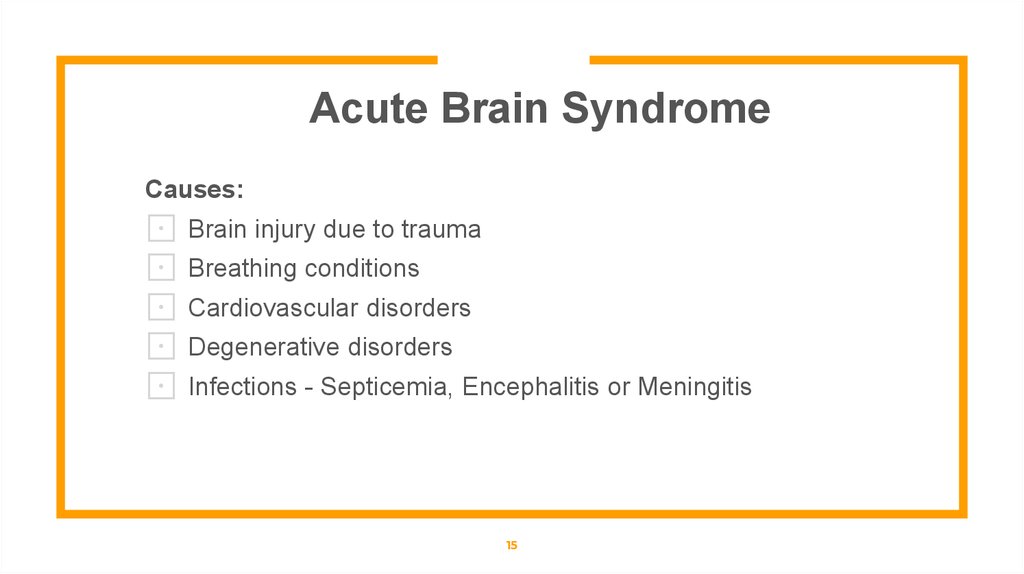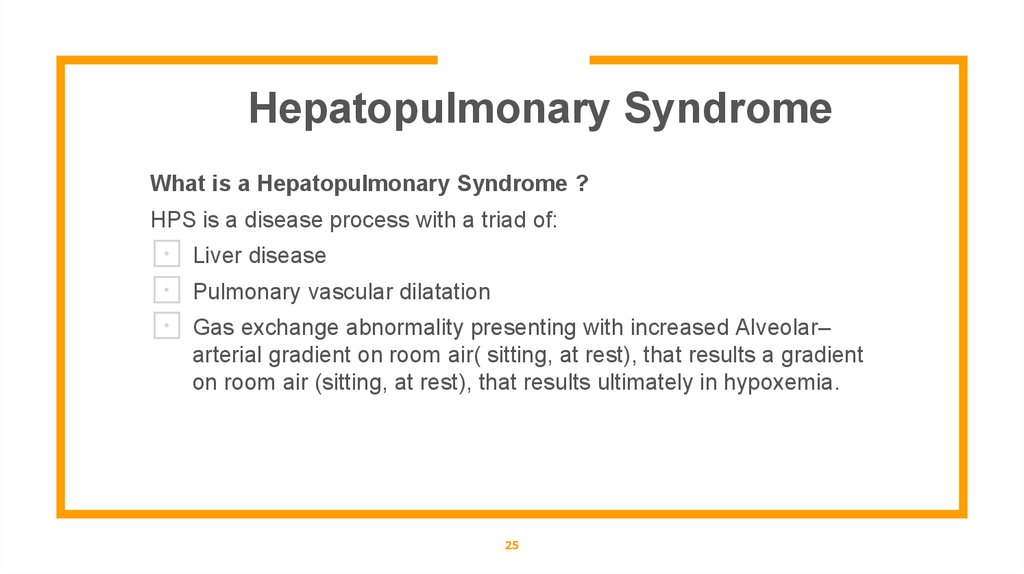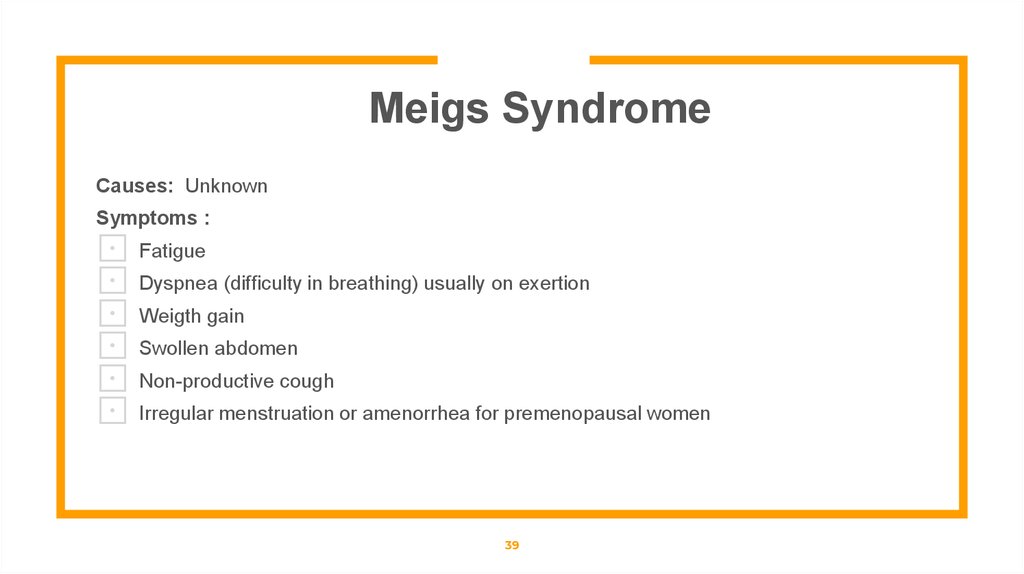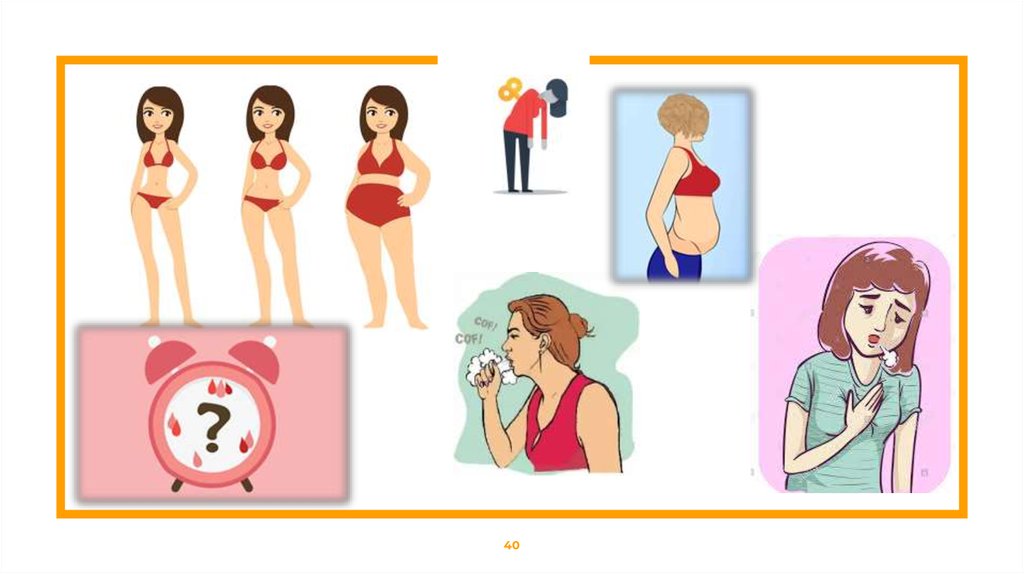Similar presentations:
Medical talks in english
1. Medical Talks in English
STAVMEDINTERNATIONAL
PRESENTS
Medical Talks
in English
The fist class
15/11/2019
2. the most frequent words
1the most frequent words
in medical English
2
3.
ISDEFINED
AS
Определяется
как
Pleural effusion is defined as excess fluid
accumulation in pleural space
3
4.
REFERSTO
Относится к
Uncomplicated UTI refers to acute cystitis
or pyelonephritis in non-pregnant
outpatient woman without anatomic
abnormalities or instrumentation of the
urinary tract.
4
5.
ISCHARACTERIZED
BY
Характеризуется
(чем-либо)
COPD is characterized by airflow
obstruction.
5
6.
OCCURВстречаются,
возникают
In the US more than 700,000 cases of
sepsis occur every year.
6
7.
Affectпоражать,
оказывать
воздействие
This disease affects 5-10% of the
population.
• It is estimated than 15% of adults in
the US are affected by GERB.
• Interactions with drugs that may affect
theophylline metabolism to be
considered.
7
8.
AREDIVIDED
INTO
Делятся на
Gallbladder are divided into two major
types: cholesterol stoned and pigment
stones.
8
9.
ARECLASSIFIED
INTO
классифицируется
на
Gastrinomas are classified into sporadic
tumors and those associated with multiple
endocrine neoplasia (MEN).
9
10.
ARECLASSIFIED
AS
Классифицируются
как
Strategies for predicting and preventing
SCD (sudden cardiac death) are
classified as primary and secondary.
10
11.
FALL INTO(categories)
Попадают в
(категории)
This drugs are fallen into four main
categories.
11
12. clinical syndromes
2clinical syndromes
you might meet in your practice
12
13.
“A SYNDROME is:
⊡ a set of medical signs and symptoms
⊡ collection of diseases which are not correlated with each
other and often associated with a particular disease or
disorder.
13
14.
Acute Brain SyndromeWhat is Acute Brain Syndrome ?
⊡ Delirium
⊡ Confusion
⊡ Disorientation
⊡ Developing suddenly in a person who was previously
psychologically normal.
14
15.
Acute Brain SyndromeCauses:
⊡ Brain injury due to trauma
⊡ Breathing conditions
⊡ Cardiovascular disorders
⊡ Degenerative disorders
⊡ Infections - Septicemia, Encephalitis or Meningitis
15
16.
1617.
Acute Brain SyndromeDiagnosis and Tests:
⊡ Electroencephalography (EEG)
⊡ Computed tomography (CT) Scan of Brain
⊡ Magnetic resonance imaging (MRI) Brain
⊡ Lumbar Puncture
17
18.
Portal hypertension⊡ Portal hypertension is hypertension in the hepatic portal
system – made up of the portal vein and its branches, that
drain from most of the intestine to the liver.
⊡ Cirrhosis is the most common cause of portal
hypertension; other, less frequent causes are therefore
grouped as non-cirrhotic portal hypertension.
18
19.
Portal hypertensionPrehepatic causes:
⊡ Portal vein thrombosis
⊡ Splenic vein thrombosis
⊡ Arteriovenous fistula
⊡ Splenomegaly (increased portal blood flow)
19
20.
Portal hypertension⊡ Granulomatous or infiltrative liver
Hepatic causes:
diseases (Gaucher,
⊡ Cirrhosis of any cause.
mucopolysaccharidosis, sarcoidosis,
⊡ Primary sclerosing cholangitis
lymphoproliferative malignancies,
⊡ Chronic pancreatitis
amyloid deposition, etc.)
⊡ Hereditary hemorrhagic telangiectasia ⊡ Toxicity (from arsenic, copper, vinyl
chloride monomers, mineral oil, vitamin
⊡ Schistosomiasis
A, azathioprine, dacarbazine,
⊡ Congenital hepatic fibrosis
methotrexate, amiodarone etc.)
⊡ Nodular regenerative hyperplasia
⊡ Viral hepatitis
⊡ Fibrosis of space of Disse
⊡ Veno-occlusive disease
⊡ Fatty liver disease
20
21.
Portal hypertensionPosthepatic causes:
⊡ Inferior vena cava
⊡ Budd–Chiari
obstruction
syndrome also known as
hepatic vein thrombosis
⊡ Right-sided heart failure,
e.g. from constrictive
pericarditis
21
22.
Portal hypertensionSigns and symptoms:
⊡ Ascites
⊡ Increased spleen size
⊡ Swollen veins of the
(splenomegaly) and spleen
function
(hypersplenism), which may
lead to lower platelet counts
(thrombocytopenia)
⊡ Anorectal varices
22
oesophagus (oesophageal
varices), which may bleed and
cause vomiting of blood
(haematemesis)
⊡ Swollen veins on the anterior
abdominal wall (sometimes
referred to as caput
medusae)
23.
2324.
Portal hypertensionDiagnosis:
⊡ Ultrasonography (US): a dilated
⊡ The hepatic venous pressure
portal vein (diameter of greater
than 13mm) is a sign of portal
hypertension
gradient (HVPG) measurement has
been accepted as the gold
standard for assessing the severity
of portal hypertension. Portal
hypertension is defined as HVPG
greater than or equal to 5 mm Hg
and is considered to be clinically
significant when HVPG exceeds 10
to 12 mm Hg
⊡ On Doppler ultrasonography, a
slow velocity of <16 cm/s in
addition to dilatation in the main
portal vein are diagnostic of portal
hypertension.
24
25.
Hepatopulmonary SyndromeWhat is a Hepatopulmonary Syndrome ?
HPS is a disease process with a triad of:
⊡ Liver disease
⊡ Pulmonary vascular dilatation
⊡ Gas exchange abnormality presenting with increased Alveolar–
arterial gradient on room air( sitting, at rest), that results a gradient
on room air (sitting, at rest), that results ultimately in hypoxemia.
25
26.
2627.
2728.
Hepatopulmonary SyndromeCause(s) :
⊡ Chronic and acute liver failure can cause formation of microscopic
intrapulmonary arteriovenous dilations.
Symptoms :
⊡ Shortness of breath
⊡ Hypoxemia
28
29.
Metabolic SyndromeWhat is a Metabolic Syndrome ?
⊡ Metabolic syndrome is the malfunctioning of energy utilization and storage. It is diagnosed
by the presence of three out of five of the following medical conditions:
⊡ Abdominal obesity
⊡ Elevated blood pressure
⊡ High serum triglycerides
⊡ Elevated fasting plasma glucose
⊡ Low levels of HDL (High density lipoproteins)
29
30.
Metabolic SyndromeCause(s) :
⊡ Stress
⊡ Overweight and obesity
⊡ Inactive or sedentary lifestyle
⊡ Aging
⊡ Diabetes mellitus type 2
⊡ Coronary heart disease
⊡ Lipodystrophy
⊡ Rheumatic diseases
⊡ Eating disorders
⊡ Schizophrenia and other psychotic
disorders
30
31.
Metabolic SyndromeSymptoms :
⊡ Central obesity (abdominal obesity,
⊡ Impaired fasting glucose
⊡ Fatty liver
⊡ Polycystic ovarian syndrome
⊡ erectile dysfunction
⊡ Hyperuricemia
visceral obesity or apple-shaped obesity)
⊡ High blood pressure
⊡ Decreased HDL cholesterol
⊡ Elevated triglyceride levels
⊡ Insulin resistance
31
32.
3233.
Metabolic SyndromeDiagnosis and Tests :
⊡ Central obesity - waist circumference
⊡ Blood glucose levels
⊡ Glucose tolerance test in prediabetics
⊡ High-Sensitivity C-reactive protein (used
greater than 102 cm or 40 inches in male
and greater than 88 cm or 35 inches in
female
as a marker to predict coronary vascular
diseases)
⊡ Blood pressure more than 130/85
⊡ Serum total cholesterol
33
34.
Malabsorption SyndromeWhat is a Malabsorption Syndrome ?
⊡ A number of disorders in which the ability to absorb certain nutrients such as
vitamin B12 and iron, into the bloodstream is difficult. Proteins,
carbohydrates, fats and nutrients in the small intestine are not absorbed
properly in the small intestine, resulting in various deficiency disorders.
34
35.
Malabsorption Syndrome⊡ Conditions affecting intestine such as
Causes:
⊡ Inflammation, disease or injury to the
celiac disease, chronic pancreatitis, cystic
fibrosis
lining of stomach and intestine
⊡ Congenital birth defects of the gall
⊡ Body’s failure to produce enzymes
bladder, liver or pancreas
required for digestion of some food
⊡ Radiation therapy causing injury to the
⊡ The above conditions are caused by
mucosal lining of the bowel
factors such as: Antibiotic use
⊡ Food poisoning, parasitic infection of the
⊡ Dairy protein allergies
gastrointestinal tract
⊡ Bacterial infections such as Whipple’s
disease
35
36.
3637.
Malabsorption SyndromeSymptoms:
⊡ Deficiency of certain nutrients cause specific symptoms:
Fats deficiency - Foul smelling, light coloured stools that are soft and bulky
⊡ Deficiency of proteins - Fluid retention, dry hair, hair loss
⊡ Excessive sugar absorption: Flatulence, explosive diarrhea
⊡ Vitamin malabsorption: Malnutrition, muscle wasting, anemia, low blood pressure
37
38.
Meigs SyndromeWhat is a Meigs Syndrome ?
⊡ Meigs syndrome presents as a triad of ascites, pleural effusion
and benign ovarian tumor. The ovarian tumor can be in the form of
fibroma, Brenner tumour or granulosa cell tumour.
38
39.
Meigs SyndromeCauses: Unknown
Symptoms :
⊡ Fatigue
⊡ Dyspnea (difficulty in breathing) usually on exertion
⊡ Weigth gain
⊡ Swollen abdomen
⊡ Non-productive cough
⊡ Irregular menstruation or amenorrhea for premenopausal women
39
40.
4041.
Premenstrual SyndromeWhat is a Premenstrual Syndrome ?
⊡ The collection of physical and emotional symptoms a woman presents during a part of her
menstrual cycle are called premenstrual syndrome. Specific symptoms may vary in each
individual but a particular woman’s pattern of symptoms is predictable.
Causes:
⊡ Hormonal changes during menstrual cycle
⊡ Chemical changes in brain during stress and emotional problems
⊡ Changes in the levels of vitamins, minerals and high sodium content cause water retention
and bloating
⊡ Family history of depression
41
42.
Premenstrual SyndromeSymptoms:
Emotional:
Physical:
⊡ Stress, anxiety, mood swings
⊡ Crying spells
⊡ Food cravings
⊡ Insomnia
⊡ Social withdrawal
⊡ Poor concentration
⊡ Changes in libido
⊡ Abdominal bloating
⊡ Weight gain and water retention
⊡ Lower back pain
⊡ Swelling or tenderness in breasts
⊡ Abdominal cramps
⊡ Constipation or diarrhea
⊡ Joint or muscle pain
⊡ Cyclic acne
42
43.
Reactive ArthritisWhat is a Reactive Arthritis ?
⊡ Reactive Arthritis is a chronic type of arthritis which exists as a combination of arthritis,
inflammation of the eyes (conjunctiva) and inflammation of the genital, urinary or
gastrointestinal systems.
Causes:
⊡ Reaction to infection in another part of the body, usually the knees, ankles, spine and feet
⊡ Sexually transmitted disease can be a trigger
⊡ Genetic mutation
43
44.
Reactive ArthritisSymptoms :
⊡ Arthritis symptoms: Pain, swelling, redness and stiffness of joints, usually involving
⊡ Conjunctivitis: Mild inflammation of the eye
⊡ Uveitis (inflammation of the eye)
⊡ Pain or burning during urination and frequent urge to urinate due to urinary tract infection,
may include inflammation of prostate or cervix
⊡ Painless ulcers on penis and pus drainage from penis
⊡ Pus-filled sores on palms, mouth, soles and penis
⊡ Small nodule rashes on soles of feet
⊡ Heart problems seen in about 10% of persons affected with Reactive Arthritis
44
45.
4546.
Drug withdrawal⊡ Drug withdrawal is the group of symptoms that occur upon the
abrupt discontinuation or decrease in intake
of medications or recreational drugs.
⊡ In order for the symptoms of withdrawal to occur, one must have
first developed a form of drug dependence. This may occur as
physical dependence, psychological dependence or both. Drug
dependence develops from consuming one or more substances
over a period of time. Dependence arises in a dose-dependent
manner and produces withdrawal symptoms that vary with the
type of drug that is consumed.
46
47.
Drug withdrawal⊡ Withdrawal symptoms from opiates include anxiety, sweating, vomiting, and
diarrhea.
⊡ Alcohol withdrawal symptoms include irritability, fatigue, shaking, sweating,
and nausea.
⊡ Withdrawal from nicotine can cause irritability, fatigue, insomnia, headache,
and difficulty concentrating.
⊡ Many prescription and legal nonprescription substances can also cause
withdrawal symptoms when individuals stop consuming them, even if they
were taken as directed by a physician.
47
48.
4849.
Munchausen SyndromeWhat is a Munchausen Syndrome ?
⊡ A Psychiatric disorder in which the person feigns illness or disease to draw
attention or sympathy.
49
50.
Munchausen SyndromeCause(s) :
⊡ Psychological disturbances due to abuse or neglect as a child
⊡ History of frequent illnesses requiring hospitalization
50
51.
5152.
Munchausen SyndromeSymptoms :
⊡ Inconsistent and dramatic medical history
⊡ Unclear symptoms that become more severe or change as the treatment begins
⊡ Relapses of the symptoms after treatment, the relapses are predictable and consistent
with certain events that makes the person feels neglected.
⊡ The person knows most of the medical terminology and textbook descriptions of the
illnesses
⊡ If the tests results are negative for certain illness, then additional symptoms appear
⊡ Symptoms manifest only in the presence of others or certain people
⊡ Eager to get medical tests, operations, etc.
⊡ Problems with identity or self-esteem
52
53.
Pica SyndromeWhat is a Pica Syndrome?
⊡ Pica disorder refers to appetite for eating non-edible and non-nutritive substances such as
chalk, paint, sand, etc. This appetite persisting more than one month at the age where
eating such objects is considered to be developmentally inappropriate.
Causes:
⊡ Mineral deficiency (deficiency of iron, calcium etc)
⊡ Chemical imbalance
⊡ Parasitosis
⊡ Celiac disease
⊡ Hookworm infection
53
54.
5455.
Restless Legs SyndromeWhat is a Restless Legs Syndrome?
⊡ Restless legs syndrome is a neurological disorder that is characterized by an irresistible
urge to move one’s body to stop uncomfortable or odd sensations, like aching muscles,
tickling sensation, itching or crawling feeling. Moving the affected body part provides
temporary relief. The sensations typically occur mostly during relaxing, reading, studying
or trying to sleep.
Causes:
⊡ Genetic - inheritance in an autosomal dominant gene
⊡ Iron deficiency found to be associated
⊡ Side-effects of medications such as antidepressants, antihistamines
⊡ Dysfunction related to neurotransmitter dopamine
55
56.
Restless Legs SyndromeSymptoms :
⊡ About 40% of members have their first symptoms before the age of 20 years
Urge to move the legs due to some uncomfortable sensations like pain, electrical current,
“pins and needles”, itching, feeling of crawling or “falling asleep”. Some people report the
urge to move their arms and other parts of the body also.
⊡ Motor restlessness
⊡ Worsening of symptoms when relaxed and during quiet wakefulness
⊡ The restlessness is an urge similar to yawning. The individuals have higher rates of
depression and anxiety
56
57.
Restless Legs SyndromeDiagnosis and Tests :
⊡ No specific diagnostic tests
Clinical examination
⊡ History of restlessness, not associated with anxiety
⊡ US National Institutes of Health criteria for diagnosis (2003) An urge to move the limbs with or without sensations.
⊡ Relief of the uncomfortable sensation with increase in activity.
⊡ Worsening of symptoms during quiet time or rest-time.
⊡ Worsening of symptoms in the evening or night.
57
58.
Serotonin SyndromeWhat is a Serotonin Syndrome ?
⊡ A collection of symptoms in response to excess serotonin on the central or peripheral
nervous system. The symptoms include cognitive, autonomic and somatic effects.
Serotonin is a chemical synthesized in the body to enable brain cells and nerve cells to
communicate with one another. Too much of it can cause excessive nerve cell activity.
Causes:
⊡ Medications such as antidepressants, that affect the body’s level of serotonin
⊡ Opioids
⊡ Psychedelics
58
59.
Serotonin SyndromeSymptoms :
⊡ Agitation or restlessness
⊡ Dilated pupils
⊡ Changes in blood pressure or
⊡ Confusion
In severe cases:
⊡ High fever
⊡ Seizures
⊡ Irregular heartbeat
⊡ Excessive sweating
⊡ Unconsciousness
temperature
⊡ Nausea, vomiting, diarrhea
⊡ Increased heart rate
⊡ Tremor, twitching of muscles
⊡ Shivering and goose bumps
59
60.
6061.
true goose-bump61
62.
Tumor Lysis SyndromeWhat is Tumor Lysis Syndrome ?
⊡ A group of metabolic complications that can occur after treatment of cancer,
usually lymphomas and leukemias. They can sometimes occur without
treatment.
Cause:
⊡ Breakdown of tumour or cancer cells
62
63.
Tumor Lysis SyndromeSymptoms :
⊡ Hyperkalemia (High potassium levels in blood)
□
□
Cardiac conduction abnormalities
Severe muscle weakness or paralysis
⊡ Hyperphosphatemia (High phosphate levels)
□
□
Acute kidney failure
Calcium phosphate crystals in kidney
⊡ Hypocalcemia (low levels of calcium)
□
□
□
□
□
Tetany (involuntary contraction of muscles)
Sudden mental incapacity, emotional lability
Parkinsonian movement disorders
Papilledema (Optic disc swelling caused by intracranial pressure)
Myopathy (disease of muscles)
63
64. Great job! You’ve deserved to take a break and have some fun
3Great job! You’ve deserved to
take a break and have some fun
Learn English Vocabulary for the Body & Doctors | Friends
64
65.
Fake it until you make it.65
66. Any questions?
Hugs!66


































































 medicine
medicine english
english








